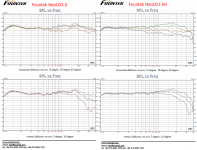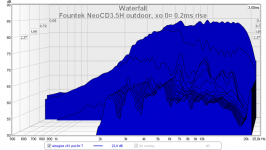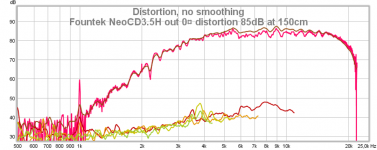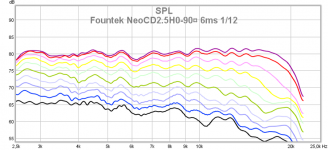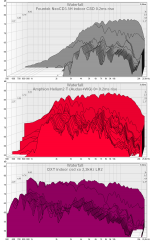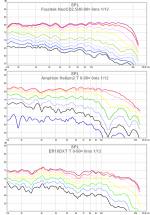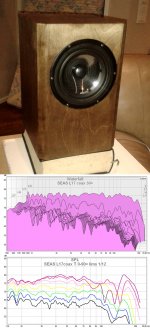Perhaps it was not fair to compare CD2 to CD3.5H
But here are Fountek's own datasheet graphs of dispersion of CD3.0 and CD3.5.
Any way - I am pleased with 3.5H and it has very wide listening angle! My measurements show that contrary to round/ellipsoid waveguides of Dave and many others - around 15kHz dispersion holds continuity better. Effect of horn termination/edge? It is almost a rule to see a dip at on-axis response of a waveguide tweeter at 15kHz - and see it disappear at 15¤ or more. This dip on-axis is perhaps the reason why many disregard waveguides and coaxials, so sad!
But here are Fountek's own datasheet graphs of dispersion of CD3.0 and CD3.5.
Any way - I am pleased with 3.5H and it has very wide listening angle! My measurements show that contrary to round/ellipsoid waveguides of Dave and many others - around 15kHz dispersion holds continuity better. Effect of horn termination/edge? It is almost a rule to see a dip at on-axis response of a waveguide tweeter at 15kHz - and see it disappear at 15¤ or more. This dip on-axis is perhaps the reason why many disregard waveguides and coaxials, so sad!
Attachments
I always had the misconception that early reflections in a horn would ruin imaging but these speakers are pinpoint accurate with imaging. They definitely get horn instruments right. I was worried about colorations but they sound so natural. More tweeters should have horn loading. I moved the cross over down to 1600hz. Its so much cleaner than a bare Xt25. I have searched and seen that some have used 8-10" wave guides with the XT25 down to 1200hz with them. It solves the high freq issues in so many mid bass drivers.
I moved around the room with the mic for the analyzer and there is no major drop off and they maintain the flat response everywhere. Its got to be the best party speaker I've built. I'm very happy with the results. I thought there would be more of a fall off in the top end of the midbass but I guess 1600-1700 sustains off axis response well.
Dave's wave guides are likely my best audio purchase in years. $70 bucks
I moved around the room with the mic for the analyzer and there is no major drop off and they maintain the flat response everywhere. Its got to be the best party speaker I've built. I'm very happy with the results. I thought there would be more of a fall off in the top end of the midbass but I guess 1600-1700 sustains off axis response well.
Dave's wave guides are likely my best audio purchase in years. $70 bucks
Anyone have any input on the sound quality of an XT25 with a wave guide vs a BMS 4550 and a seos 10 or 12 wave guide? I can flatten frequency response. I'm just curious about quality of sound as far as distortion or resonances that cant be fixed. As an example of what I mean, some say the Selenium 220 has a tizzy sound to it.
I figure the pro driver would be the last word in transients and clean high output sound being that it would be playing at a fraction of its output capability even at high volume in a home application.
I figure the pro driver would be the last word in transients and clean high output sound being that it would be playing at a fraction of its output capability even at high volume in a home application.
... This started as an RS150/ XT25TG30 combo for the top of a three way. I ended up switching out to the ER18 and the LD25X. Although twice the money IMO i think well worth it...
If Zaph's distortion measurements are to be trusted (and I think they are) then there really would seem to be zero benefit to trying to find another tweeter with lower distortion - the XT25 + waveguide combo is already absurdly low once a crossover is added (better than all the $200 - $300 or even higher non-wg tweeters I've seen).
And I've seen enough comments about the XT25's phase plug providing some benefit in waveguide applications that I think you might even be taking a step down, not up, moving to the LD25X from the XT25?
That's for a pair?Dave's wave guides are likely my best audio purchase in years. $70 bucks
Last edited:
I had both set up with a 6.5" somewhat elliptical waveguide crossed around 2kHz I believe. I thought they both sounded better crossed at this point rather then lower although the polars looked as good lower. I just thought the LD25X sounded quit a bit more detailed. I switched to the ER18 after the tweeter switch and I preferred it. Maybe 2kHz was to high to cross the RS150. This is just my opinion listening to one unfinished speaker but I was convinced enough to move forward with the LD25X/ ER18 combo. Although I still haven't got back to finishing the second speaker so I really haven't moved forward. I thinks it's a Moot point anyway since the LD25X is no longer available with the removable faceplate and that's what was needed to fit my guide to.
Dave
Dave
If Zaph's distortion measurements are to be trusted (and I think they are) then there really would seem to be zero benefit to trying to find another tweeter with lower distortion - the XT25 + waveguide combo is already absurdly low once a crossover is added (better than all the $200 - $300 or even higher non-wg tweeters I've seen).
And I've seen enough comments about the XT25's phase plug providing some benefit in waveguide applications that I think you might even be taking a step down, not up, moving to the LD25X from the XT25?
That's for a pair?
Perhaps it was not fair to compare CD2 to CD3.5H
But here are Fountek's own datasheet graphs of dispersion of CD3.0 and CD3.5.
Any way - I am pleased with 3.5H and it has very wide listening angle! My measurements show that contrary to round/ellipsoid waveguides of Dave and many others - around 15kHz dispersion holds continuity better. Effect of horn termination/edge? It is almost a rule to see a dip at on-axis response of a waveguide tweeter at 15kHz - and see it disappear at 15¤ or more. This dip on-axis is perhaps the reason why many disregard waveguides and coaxials, so sad!
Waterfall plots / distortion didn't look so good with the 3.5H from the measurements from the only person that I've seen post such measurements, could you post those measurements? I'd like to see a second opinion. Maybe I'll try the 3.5H (I already have some Vifa XT25 tweeters and the 6.5 inch waveguides, but I've yet to machine them to fit...) I was also thinking about the D.P. waveguides. $70 for a pair of the waveguides seems a bit too expensive - but, since I aready have the XT25 tweeters, I suppose it is less than buying a pair of 3.5H...
Last edited:
I usually have pretty good luck removing that dip. It really depends on the tweeter. Sometimes there is no dip at all. Other times I can remove it with a step between the adapter plate and the guide. Sometimes a phase plug works but usually it creates other problems. I've been able to remove it on axis then have it show up off axis. As I said it just depends on the tweeter and I'm not sure why it happens. It does seem to have to do with the throat size. If I reduce down so the throat is the size of the dome that will sometimes remove it.My measurements show that contrary to round/ellipsoid waveguides of Dave and many others - around 15kHz dispersion holds continuity better. Effect of horn termination/edge? It is almost a rule to see a dip at on-axis response of a waveguide tweeter at 15kHz - and see it disappear at 15¤ or more. This dip on-axis is perhaps the reason why many disregard waveguides and coaxials, so sad!
Dave
critofur, my Fountek NeoCD3.5H is nude and it is a part of my AINOgradient. I have lots of measurements of it. Here outdoor csd and distortion measured at 150cm. Xo is done by minidsp and if I remember right it is LR2 at3000Hz or like here. The directivity is 10¤ intervals 6ms gating, distance 120cm, xo at 3300Hz LR4.
I believe this is as good as it can be! The horn helps the speaker to maintain low distortion and I have tested it wit 2200Hz LR4 without any problems with distortion, but of course the there is some. A wider frame would make directivity worse I guess or at leas make more diffractions. Here the frame is the driver's own frame w=98mm. The baffle thickness is 12mm+4mm from the driver.
I believe this is as good as it can be! The horn helps the speaker to maintain low distortion and I have tested it wit 2200Hz LR4 without any problems with distortion, but of course the there is some. A wider frame would make directivity worse I guess or at leas make more diffractions. Here the frame is the driver's own frame w=98mm. The baffle thickness is 12mm+4mm from the driver.
Attachments
Here are my similar indoor measurements of the Audax tweeter with a waveguide in Amphion Helium2 and directivity of SEAS 27DXT in cabinet w= 195mm driver offset and nude Fountek NeoCD3.5H. The dxt is measured as complete speaker like all directivities) Amphion and ER18DXT speakers measured at height between w and t (T is not on-axis at 0¤!!!)
Added SEAS L17 coaxial (Hifitalo special) in box w=195mm
Added SEAS L17 coaxial (Hifitalo special) in box w=195mm
Attachments
Last edited:
You cant hear a dip at 15k and above.
The dispersion of all ribbons is fine in the horizontal plane because the width of a ribbon is typically 3/4" or less.
Its the vertical dispersion thats bad.
it's not "bad" per say, rather limited which can be used if addressed carefully.
On the side note, the direct comparison of my distortion data and Zaph's is incorrect because of the difference in the measurement conditions. Distortion of the driver are related to the SPL or perhaps product of it and my data is not gathered with the same standardizing as Zaph's. Having said that, I agree with your conclusion of lower distortion numbers of 2.0 compare to 3.5H. If the same voltage/spl conditions are applied, 2.0 is a lower distortion, higher performance driver. (the limitation of 2.0 tho is it's laser like vertical off axis response) .
" laser like vertical off axis"
The height of 2.0 is some 170mm. But there are many other riibbons that are even longer eg. Radian RD line drivers.
Is is possible at all to make a tweeter that satisfies all these controversial desires? Someone emphasizes low distortion, other strong directivity, third wide directivity.
The complete loudspeaker is always a bunch of compromises. I they are matched, the result is "homogenous" and in the right environtment it works.
Simple as that, isn't it
The height of 2.0 is some 170mm. But there are many other riibbons that are even longer eg. Radian RD line drivers.
Is is possible at all to make a tweeter that satisfies all these controversial desires? Someone emphasizes low distortion, other strong directivity, third wide directivity.
The complete loudspeaker is always a bunch of compromises. I they are matched, the result is "homogenous" and in the right environtment it works.
Simple as that, isn't it

" laser like vertical off axis"
The height of 2.0 is some 170mm. But there are many other riibbons that are even longer eg. Radian RD line drivers.
Is is possible at all to make a tweeter that satisfies all these controversial desires? Someone emphasizes low distortion, other strong directivity, third wide directivity.
The complete loudspeaker is always a bunch of compromises. I they are matched, the result is "homogenous" and in the right environtment it works.
Simple as that, isn't it
It wasn't a critique of the driver, rather description of properties. It is of course up to the designer, how to implement it to best suite the concept.
IMO Fountek 2.0 is one of the better performing tweeters $/inch for line array builds. For a conventional 2-way design, I would use a something else.
But yes, it's very directional vertically....... which can be a bad thing........ or a good one.
OMG!!! Those David Pellegrine's amt+double wg measurements are from heaven on a sunny day! This makes me really hungry!

David's woofer is in a frame that is far form ideal as a dipole. It should be relatively easy to find the right diameter for a nudie mid to xo around 2kHz LR4 and end up with consistent directivity.
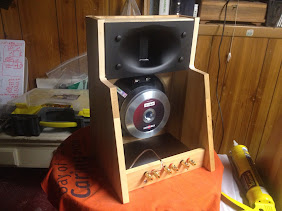
Many people want to get backward radiation to as higf Fq as possible, but I'm not so sure about it being wise. I for example have windows right behind the speaker, and they are like mirrors at high Fq - too much reflections???
Where is this from?
I was trying to see if Pellegrene has ever made a waveguide for a ribbon, and this pic of yours was all I could find.
Have you clicked on the Picasa link in the sidebar on Dave's site?
There are a lot more waveguides than appear on his price list.
Here's the linky if it works (I've had a couple of problems recently):
https://plus.google.com/photos/101632266659473725850/albums?banner=pwa
There are a lot more waveguides than appear on his price list.
Here's the linky if it works (I've had a couple of problems recently):
https://plus.google.com/photos/101632266659473725850/albums?banner=pwa
Have you clicked on the Picasa link in the sidebar on Dave's site?
There are a lot more waveguides than appear on his price list.
Here's the linky if it works (I've had a couple of problems recently):
https://plus.google.com/photos/101632266659473725850/albums?banner=pwa
There it is! Thank you.
A google 'search by image' provides a build thread here : Open Back Speaker Build - Page 5
- Status
- This old topic is closed. If you want to reopen this topic, contact a moderator using the "Report Post" button.
- Home
- Loudspeakers
- Multi-Way
- My first wave guide speaker....lots of pics
